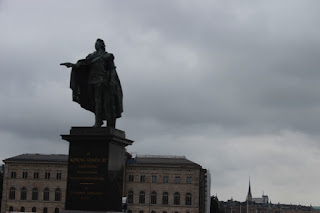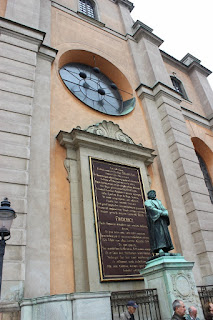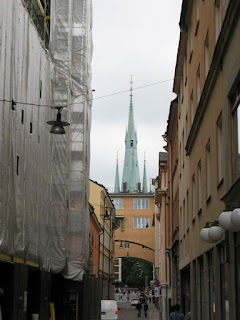
An unbelievable sail-in! We never expected this. Mile after mile after mile – a combination Panama Canal and Alaska’s Inside Passage. Absolutely beautiful…stunning! And thousands of tiny islands – literally. Our travel guide said something like 30,000 islands. The sailaway was just as beautiful. Very narrow waterways, with the hillsides dotted with small summer cabins & lovely cottages. Towering pine trees in some areas. It took us the better part of 3 hours before reaching open ocean, with live commentary broadcast throughout the ship by the onboard travel guide, Dorinna. She’s a middle-age gal from the Netherlands, and we’ve actually become quite good friends over the past few weeks. Probably the best travel guide we’ve ever had. Very knowledgeable about this part of the world with a great personality.
So, Stockholm is the capital of Sweden and the most populous city in the Nordic countries – just south of 1 million…approximately 1.5 million in the urban area, and 2.3 million in the metropolitan area. The city is spread across a total of 17 islands on the coast in the southeast of Sweden at the mouth of Lake Malaren, by the Stockholm archipelago and the Baltic Sea. But again, thousands of tiny islands dot the archipelago as you sail-in. It’s a unique sailing experience, in and of itself.
The city is home to some of Europe's top ranking universities, such as the Stockholm School of Economics, Karolinska Institute and Royal Institute of Technology. And something we didn’t realize…it hosts the annual Nobel Prize ceremonies and banquet at the Stockholm Concert Hall and Stockholm City Hall. I’m sure we’ve heard it mentioned before at some point over the years, but you remember some trivia and some not! We were able to visit the location during our walking tour through Old Town. One of the city's most prized museums, the Vasa Museum, is the most visited non-art museum in Scandinavia. The Stockholm metro, opened in 1950, is well known for its decoration of the stations; it has been called the longest art gallery in the world, and easy to understand why. Incredible! Sweden's national football arena is located north of the city center, in Solna. Ericsson Globe, the national indoor arena, is in the southern part of the city.
We’re told that currently, Stockholm's metropolitan area is one of the fastest-growing regions in Europe, and its population is expected to number 2.5 million by 2024. As a result of this massive population growth, it has been proposed to build densely-packed high-rise building in the city center connected by high-rise walkways. Apparently, there’s a lot of controversy around this.
I will share with you, we thought St. Pete was a much cleaner city. We were actually disappointed, particularly after such a spectacular sail-in. Our expectations were set pretty high. It wasn’t disgusting by any stretch, just not as well-maintained as many other cities we’ve been to this trip. The pedestrian walkways were plastered with gum, stains, and most garbage cans were left overflowing. I’m a neat-freak by personality, so maybe I’m a little over the top here, but I like value and appreciate cleanliness & organization. Stockholm overall just didn’t measure up for us personally. With that said, and in all fairness, I should share with you that the city was granted the 2010 European Green Capital Award by the EU Commission; this was Europe's first "green capital". Applicant cities were evaluated in several ways: climate change, local transport, public green areas, air quality, noise, waste, water consumption, waste water treatment, sustainable utilization of land, biodiversity and environmental management. Out of 35 participant cities, eight finalists were chosen: Stockholm, Amsterdam, Bristol, Copenhagen, Freiburg, Hamburg, Munster, and Oslo. Some of the reasons why Stockholm won the 2010 European Green Capital Award were: its integrated administrative system, which ensures that environmental aspects are considered in budgets, operational planning, reporting, and monitoring; its cut in carbon dioxide emissions by 25% per capita in ten years; and its decision towards being fossil fuel free by 2050. They say Stockholm has long demonstrated concern for the environment. The city's current environmental program is the fifth since the first one was established in the mid-1970s.
The vast majority of folks work in the service industry, which they say accounts for roughly 85% of jobs. The last decade has seen a significant number of jobs created in high technology companies. Large employers include IBM, Ericsson, and Electrolux. A major IT center is located in Kista, in the northern part of the city.
The oldest section is Gamla Stan (Old Town), located on the original small islands of the city's earliest settlements and still featuring the medieval street layout. That’s where we spent the majority of our time. Some notable buildings of Gamla Stan are the large German Church (Tyska kyrkan) and several mansions and palaces: the Riddarhuset (the House of Nobility), the Bonde Palace, the Tessin Palace and the Oxenstierna Palace.
The oldest building in Stockholm is the Riddarholmskyrkan from the late 13th century. After a fire in 1697 when the original medieval castle was destroyed, Stockholm Palace was erected in a baroque style. Storkyrkan Cathedral, the episcopal seat of the Bishop of Stockholm, stands next to the castle. It was founded in the 13th century but is clad in a baroque exterior dating to the 18th century. Check out the pics!
After visiting St. Petersburg and to our surprise, they told us that Stockholm is one of the most crowded museum-cities in the world with around 100 museums, visited by millions of people every year. The Vasa Museum is a maritime museum which displays the only almost fully intact 17th century ship that has ever been salvaged, the 64-gun warship Vasa that sank on her maiden voyage in 1628. Amazing!
The National Museum houses the largest collection of art in the country: 16,000 paintings and 30,000 objects of art handicraft. You guessed it…not on our schedule. Also, the Museum of Modern Art…apparently it has works by noted modern artists such as Picasso and Salvador Dalí. Skansen (in English: the Sconce) is a combined open-air museum and zoo. Oh…and ABBA…(The Museum) an interactive exhibit about the pop-group ABBA. The evening before our arrival, ship entertainment was devoted to ABBA – very nice, but not great. There are many more museums, far too numerous to list here.
Directly across from where we docked…the Grona Lund - an amusement park located on the island of Djurgarden…NOW WE’RE TALKIN’ 😊….over 30 attractions and many restaurants. It’s a very popular tourist attraction and we were tempted to spend a few hours there, but with rain in the forecast and only a few hours to tour, we passed on it.














































































































































































No comments:
Post a Comment